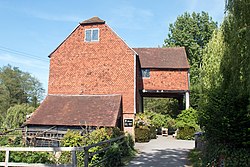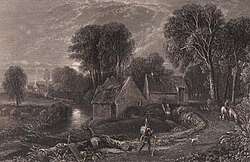
The use of water power in Britain was at its peak just before the Industrial Revolution. The need for power was great and steam power had not yet become established. It is estimated that at this time there were well in excess of ten thousand watermills in the country. Most of these were corn mills (to grind flour), but almost any industrial process needing motive power, beyond that available from the muscles of men or animals, used a water wheel, unless a windmill was preferred.
Contents
- England
- Bedfordshire
- Berkshire
- Buckinghamshire
- Cambridgeshire
- Cheshire
- Cornwall
- Cumbria
- Derbyshire
- Devon
- Dorset
- Durham
- East Sussex
- East Yorkshire
- Essex
- Gloucestershire
- Greater London
- Hampshire
- Hertfordshire
- Isle of Wight
- Kent
- Lancashire
- Leicestershire
- Lincolnshire
- Norfolk
- Northamptonshire
- North Yorkshire
- Northumberland
- Nottinghamshire
- Oxfordshire
- Shropshire
- Somerset
- South Yorkshire
- Staffordshire
- Suffolk
- Surrey
- Tyne and Wear
- Warwickshire
- West Midlands
- West Sussex
- West Yorkshire
- Wiltshire
- Worcestershire
- Scotland
- Aberdeenshire
- Angus
- Dumfries and Galloway
- East Ayrshire
- East Lothian
- East Renfrewshire
- Highlands
- Lanarkshire
- Moray
- North Ayrshire
- Orkney
- Perthshire
- Renfrewshire
- Scottish Borders
- Shetland
- South Ayrshire
- Western Isles
- West Lothian
- Northern Ireland
- County Antrim
- County Down
- County Fermanagh
- County Tyrone
- Wales
- Clwyd
- Dyfed
- Gwent
- Gwynedd
- Mid Glamorgan
- Powys
- South Glamorgan
- West Glamorgan
- See also
- References
- Bibliography
- External links
Today only a fraction of these mills survive. Many are used as private residences, or have been converted into offices. At least one is now a whiskey distillery, and another is a gin distillery. A number have been preserved or restored as museums where the public can see the mill in operation.
This is a list of some of the surviving watermills and tide mills in the United Kingdom.
Listen to the water mill
Through the livelong day;
How the clicking of the wheel
Wears the hours away.
Languidly the autumn wind
Stirs the withered leaves;
On the field the reapers sing
Binding up the sheaves;
And a proverb haunts my mind
And as a spell is cast,
"The mill will never grind
With the water that has passed."
Excerpt
See yon our little mill that clacks
so busy by the brook,
She has ground her corn and paid her tax
ever since Domesday Book.































































